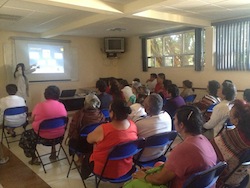Saturday’s column described how in the span of one decade, Mexico achieved universal health care by enrolling its 52.6 million uninsured people (half the population) and dramatically improved health.
But during the same decade, the eating habits of the population changed, and a diet has emerged in Mexico that is a far more efficient killer than the notorious drug cartels.
This month, a United Nations report announced that with a 32.8 percent adult obesity rate, Mexico surpassed the United States (with 31.8 percent) as the most overweight of the industrialized nations. Twenty-one million people (one fifth of the population) are clinically obese — an incredible 38 percent rise since 2000. About 70 percent of Mexican adults are overweight, while childhood obesity tripled in a decade.

A doctor teaches an attentive audience what constitutes a proper breakfast at the Centro de Salud in Querétaro, Mexico. In July, the United Nations announced Mexico surpassed the U.S. as the heaviest industrialized nation.
Only 40 years ago, Mexicans were lean and consumed a diet dominated by maize and beans. They mainly lived on the land, worked hard physical labor and couldn’t afford a daily feast. The main causes of death were malnutrition and infectious diseases.
In the past decade, rural families are abandoning the land, and urban jobs are less physically taxing. The Mexican diet morphed into one high in processed fats and sugars, and now Mexico’s biggest killers are cardiovascular diseases and diabetes, together accounting for 150,000 deaths in 2012, according to the World Health Organization. One in six Mexican adults suffers from diabetes, which kills 70,000 each year — roughly equal to the deaths authorities say are caused by more than six years of the country’s gangland wars.
Tamales, tacos and tostadas, once reserved for special occasions and loaded with carbohydrates and lard, now get gobbled daily. Last month, during a weeklong Spanish immersion trip for health care professionals, I saw a different Mexico than the one where I went to school in the 1960s. The streets of Querétaro, Guanajuato and San Miguel de Allende were chock full of vendors selling calorific snacks like deep-fried pork skin, doughnuts, ice cream, hot dogs, hamburgers, quesadillas filled with cheese and deep-fried plantains (the only fruit-vegetable in sight).
And sodas. The nation’s famous sweet tooth has been ever so successfully exploited by the fizzy drinks industry. Mexicans drink more refrescos than any other country. Research presented at an American Heart Association conference in March found that sugary drinks accounted for 22,000 deaths in Mexico every year — the highest rate in the world.
In el Centro de Salud Dr. Pedro Escobedo in Querétaro, Dr. Salvador Jiménez del Prado allowed me to observe a full classroom where a doctor was teaching people about nutrition. The word at the top of the screen was desayuno (breakfast), and she was pointing to the food groups that constitute a proper one. It’s no accident that she was teaching about breakfast. Seven out of 10 children in rural communities have a sugary drink with breakfast, according to the campaign group Power of the Consumer.
The local economy opened to global marketers in the 1990s. It was startling for me to see Burger King, Domino’s Pizza and McDonald’s littering the downtown areas of the cities. Everywhere I turned I saw an Oxxo fast food convenience store; indeed, more than 1,000 outlets opened in 2011.
An epidemic this massive is not just about bad food choices. Processed food high in saturated fats, sugar and additives goes on the table as more women work outside the home and cook less. Food industry lobbies, like Pepsi, Nestlé, Coca Cola and Bimbo, have deep pockets and are intensely organized. Lax regulation allows adults and children to be shamelessly bombarded, in Spanish and indigenous languages, with advertising for processed snacks and sugary drinks via television, billboards and markets.
Mexico and the United States are the two most overweight of the industrialized nations. Unless both countries combat our obesity problem, the health benefits of universal coverage will be sabotaged.

 Austin, Texas
Austin, Texas